Stories
A Prevalence of White
1980-2000
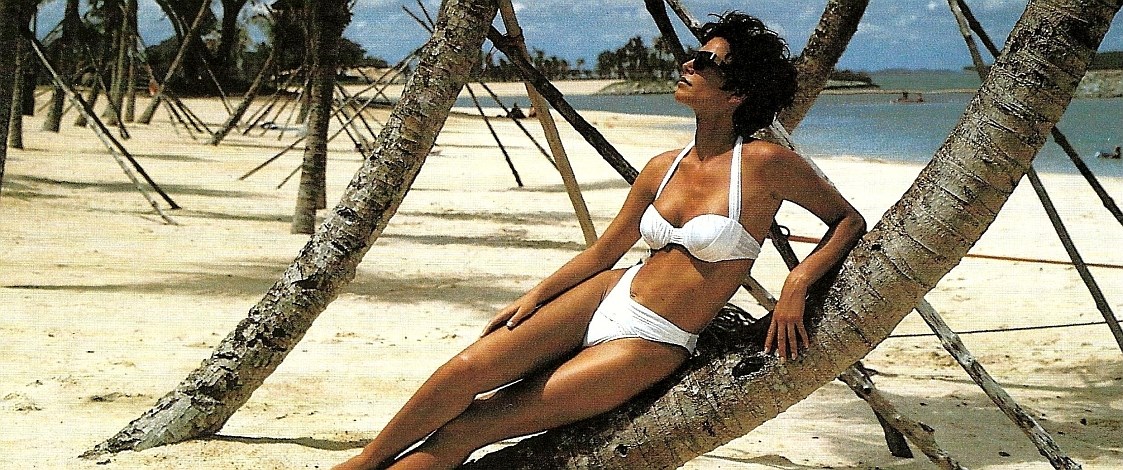
White, like black, is never out of fashion. But there are times when it is more popular than others. During the 1980s and 1990s white really came into its own. New Zealand fashion designers were beguiled by it and fashion editors were equally enamoured. Page after page of white fashions appeared in local magazines. Story headings ranged from the simple - 'White Magic', 'White Hot' - to the sublime - 'A Midsummer White’s Dream'.
The length that defined the early 1980s was 'long', mid-calf or to the ankle. The dressier pure white pieces, particularly when sharp pleats were involved, exuded a pedigreed crispness. Design was often unrevolutionary but demonstrated that good taste is never dull and that some fashion conventions such as the tailored jacket and classic pant or skirt combination were worth keeping.
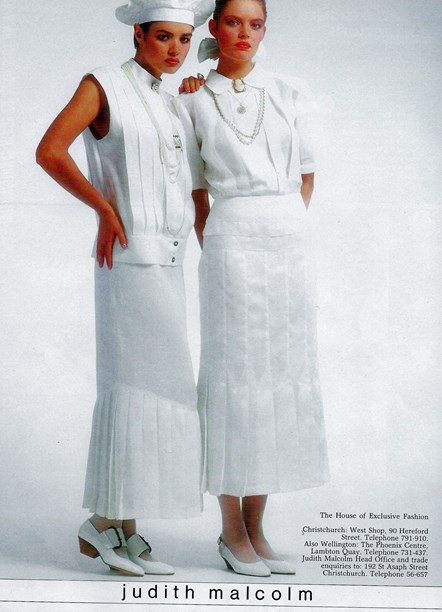
Advertisement for dressy pleated separates by Christchurch designer Judith Malcolm, 1985.
The lightest shade of pale, white lent itself to delicate details. Demure dresses in soft white cotton were rendered even more romantic with the addition of ruffles, pin-tucks, lace inserts or broderie anglaise trim. This was a youthful look, best worn by the young.
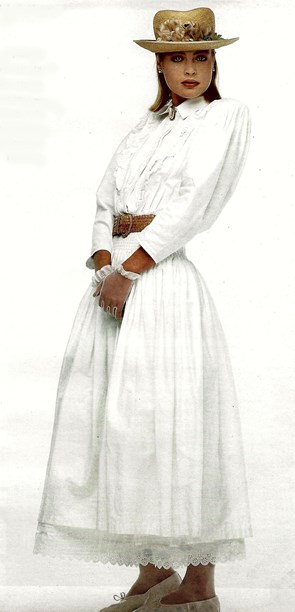
Tucks, ruffles and shirring define a washer cotton dress by Earlybird. Photographer Desmond Williams. Fashion Quarterly, Spring 1987.
As changes in attitudes and social mores occurred, they found an echo in fashion. The mid-to-late ‘80s obsession with status, wealth and non-stop partying saw white clothing presented in a different way - short, sharp and shapely by day, frivolous and fanciful by night.

Adrienne Winkelmann white linen suit with multi-coloured vertical stripes. Fashion Quarterly, Summer 1989.
Linen, Lycra and Leather
Of all the white fashion fabrics, linen, used to make dresses, skirts, jackets and pants, was an undisputed favourite. Beloved of Rosaria Hall, Trelise Cooper, Keith Matheson, Jane Daniels and other designers of that ilk, white linen had a certain cachet. For white outfits comprising more than one garment, monochromatic monotony was avoided by mixing fabrics with different textures, knits with lace, for example or, as exemplified by Nita Henry in her Wild West saloon-style dance dresses, tulle with leather. Brigid Brock, who created body-delineating white leather suits, sourced her skins from an Italian tannery producing only white leather and whose floor was painted white to keep the product clean.
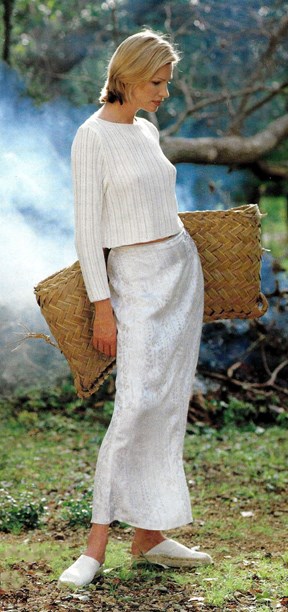
Texture mix. Cropped ribbon-knit top and ankle-length brocade skirt by Zambesi. Fashion Quarterly, Summer 1994.
The introduction of Lycra added another dimension, resulting in white catsuits, bike pants, lace-up bodysuits and figure-hugging tops. Designed for night-clubbing, Moontide’s velvet Lycra hot pants and under-wired midriff top embellished with jewels, showed just how seductive white could be in a super-stretch fabric. White Lycra also had a big impact on swimwear. Emphasising not just a shapely figure but sun-bronzed skin, it continued to be a fashionable option while natural tanning did not.

Moontide advertisement for Grecian-style one-piece, 1992.
Weekend Whites
With the exception of black, no other colour is a better foil for white than navy blue. This was recognised as far back as 1939 when the NZ Mirror’s fashion columnist wrote that "on a sunny day, white is the ideal wear for going down to the sea" and suggested a double-breasted white jacket and navy slacks as suitable attire. The nautical reference is unmistakable as it was throughout the 1980s and '90s when advocates of white and navy, most notably Thornton Hall, Peppertree, Trelise Cooper and Dreamgirls, embraced the trend.
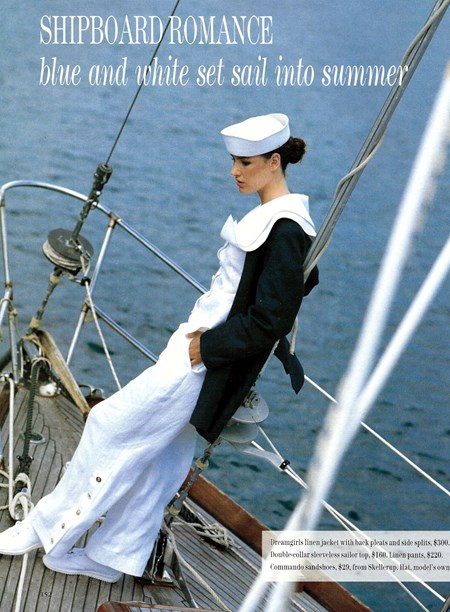
Dreamgirls nautical-look linen jacket, linen pants and sleeveless sailor top with double collar. More Fashion, Spring 1990.
The growing demand for stylish casual clothing motivated designers, innovative newcomers and established labels alike, to explore the possibilities of white for leisurewear. Looks ranged from strapless sarongs, wrap-and-tie skirts and halter tops to loose-fitting pants, softly draped jumpsuits and hand-crocheted cotton cardigans. The mid-90s’ trend for sheer fabrics produced a plethora of filmy dresses - "as light as a summer breeze", according to More Fashion magazine - designed by the likes of Glory and State of Grace. Shorts-suits were popular for work and play.

Crinkle-cotton long-line jacket and long shorts. From Mainstreet collection, Summer 1988.
White Icons
The plain white t-shirt became a wardrobe basic. It neither proposed nor imposed so could be worn any which way - tucked into jeans, sassed up with a piece of jewellery or as a counterpoint to a serious suit. Finding an unadulterated white cotton t-shirt in New Zealand wasn’t always easy so women often resorted to menswear ranges in their search for the perfect T. Considering the t-shirt’s origin, this was of some historic interest. White t-shirts started life as part of the regulation kit for American GIs and the US Navy during World War II and were worn by servicemen as singlets. Only later were they made in women’s sizes.
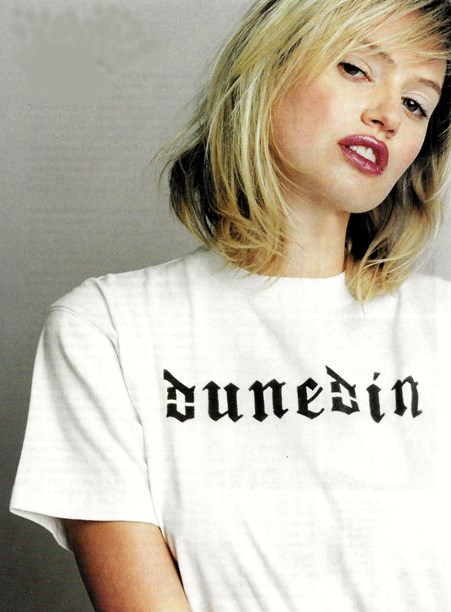
White t-shirts were not always plain. This Nom*d t-shirt was photographed for Style magazine in 2000.
The white shirt was another menswear item to become a female fashion classic. In its most literal iteration it had all the features of a man’s shirt but was proportionately smaller, though not so small that it wouldn’t lend itself to improvisation. It needed to be long enough to tie in front, roomy enough to double as a jacket over a t-shirt or singlet. Fancier versions with ruffles, jabots or bows were worn to soften up suits or add a feminine touch to more androgynous pieces. In the 1990s, Jane Mabee (formerly of Betsy Ruff) created Paperwhites, a line of white dress shirts made from Swiss organdy, Italian and French silk and quality Japanese shirting. She embellished them with crystal or pearl buttons and fine lace trims. A long-time champion of the white shirt, Fashion Quarterly exhorted its readers: "Whatever you do, please don’t call it a blouse!"

Rosatti by Rosaria Hall Italian linen shirt and Italian linen twill pants, 1989.
Showtime
Fashion parades, such as the Corbans (later Wella) Fashion Collections, provided the ideal platform for designers and manufacturers to showcase their seasonal whites. In 1991, the accent was on white swimsuits, culottes and bustiers, drop-waisted dresses, pleated skirts and belted suits . The following year, in the couture section of the event, Peter Homan of David Carmody demonstrated his flair for show-stopping evening gowns. A flurry of white feathers, embroidery and beading, his creations recalled the 1930s’ Hollywood glamour of Ginger Rogers and Fred Astaire, much as his Gatsby-inspired, crystal- beaded white gown - winner of the Benson & Hedges Supreme Award in 1972 - had evoked nostalgia for the 1920s.
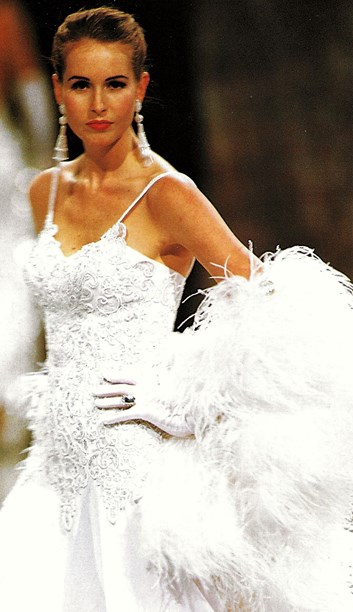
Evening gown designed by Peter Homan for David Carmody. Corban’s Fashion Collections, 1992.
Utilitarian Chic
At the end of the ‘90s, a white trend emerged that was almost clinical in its uniform-like simplicity. Central to the look were separates. Cut on clean angular lines, they were indicative of the architectural influences creeping into the construction of garments at that time. Proponents of the look included Sister (Kate Sylvester), Karen Walker and Ashley Fogel.
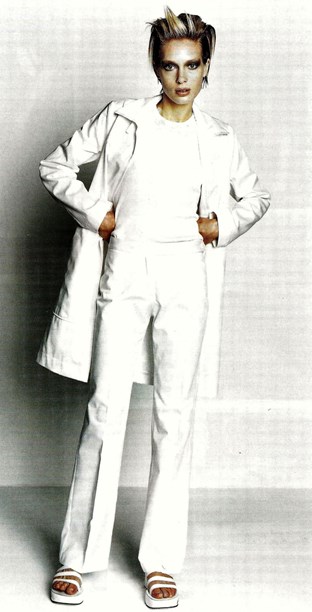
Karen Walker cotton drill trench-coat and pants worn with a cotton rib singlet. Fashion Quarterly, Spring 1998.
One of the earliest local references to white clothing appeared in the 1849 Handbook for Intending Emigrants to the Southern Settlements of New Zealand. Ladies were advised to bring, among other wardrobe items, "48 white cambric chemises and 8 white muslin gowns". At the dawn of the new millennium, long after cambric chemises and muslin gowns had been consigned to history, white remained, and still remains, a favoured fashion colour.
Text by Cecilie Geary. Banner image of a Moontide ruched two-piece with basketweave detail. Fashion Quarterly, Summer 1992.
Published September 2020.